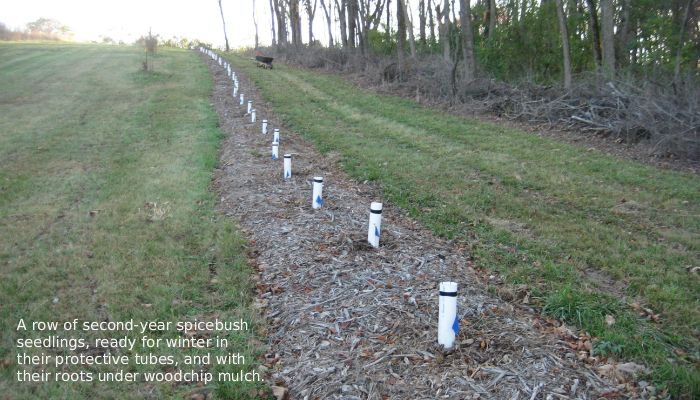Autumn Bareroot Transplants Have Problems in Iowa

If you read gardening magazines and nursery catalogs, they often promote bareroot transplants of seedling trees and shrubs in autumn, citing the advantage of additional time to get established belowground, before the demands of spring top growth.
However, most of these are aimed at a national audience. And, their message is correct for autumn transplants as near as Illinois and Missouri. But in Iowa, autumn bareroot plantings often have a high mortality rate. Why?
- We tend to have dryer autumns, 2017 being a good example. Not favorable for bareroot transplants, which have often already lost some root in the process, and the remaining portion has poor soil contact in its new home.
- Our shallow soils typically go through a lot of freeze-thaw cycles. In Minnesota, it typically just stays frozen for long periods, while in Missouri it only freezes occasionally. Frost heave tends to lift the new roots up, and freeze drying dehydrates them in the numerous air pockets in the newly emplaced soil.
Spring planting is usually the better option here, giving the bareroot seedling a whole growing season to get anchored. But if it needs to be autumn, here are some ways to considerably improve the odds:
- Use a hydrolyzed starch root dip. A cheap powder you buy under many brand names, mine says Super Slurper. Mixed with water it forms a slimy gel that clings to roots and helps keep them from drying out. After planting, it rehydrates with rain or watering.
- Use the puddling method to plant. Dig a somewhat oversize bowl-shaped hole, plant the seedling and completely flood with water. Then jiggle the saturated soil repeatedly with your foot, turning it into a slurry of mud, as flowable as thick latex paint. Often necessary to hold the little plant in place with your fingers while working your way around it with your foot.
- Mulch thoroughly, several inches thick, and at least 18 inches diameter. Water often and thoroughly.
- Protect from deer and rabbits, especially deer, because they will simply pull the unprotected seedling completely out of the ground, which is 100% fatal. My method to protect them, 95% successful, is to cut cheap thinwall, 3-inch PVC “sewer and drain” pipe into 15 inch lengths. Slip a tube over each seedling while dormant, anchored with a 2 foot long wooden stake pounded in firmly, and attached with a few windings of electrical tape near the top. The mulch holds the bottom in place, especially after it freezes.
Remove next spring when they begin to leaf out. But next November, if they will still fit back inside, put the tubes back on for another winter, see photo. Store pipe and stakes under shelter for summer and they will remain reusable. Thinwall 3-inch PVC pipe is no longer carried by Lowes or Menards. You will need to locate another source, or use the heavier grade schedule 40, or use 4-inch thinwall.
Seedlings which grew all summer in posts can be field planted in autumn with fewer issues, as long as the dirt doesn’t crumble away from the roots while removing them from the pot. But mulch, water, and protection from browsing are still important.


